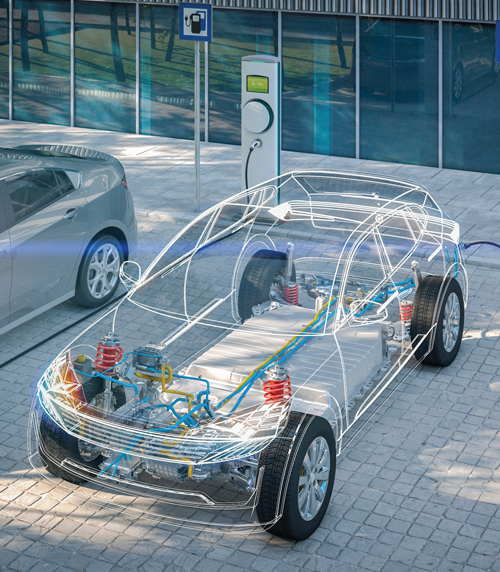Use of Composites in Batteries
Composite materials are used in many fields with the developing technology. One of the areas where composite materials are used is batteries. With the emergence of electric cars, the importance of rechargeable batteries has increased.
At this point, Li-Ion batteries with fast charging features stand out. The use of electric cars is increasing day by day. Carbon emissions have a big role in the climate crisis that our
world is facing. For this reason, consumers have started to prefer the use of electric vehicles.
Increasing demand has also increased the development work on these tools. The most emphasized issue here is to increase battery capacities and to lighten vehicles. Short vehicle range is one of the biggest problems in electric vehicles.
The lightness of the vehicle will reduce the energy consumed by the electric motor and will ensure that the battery lasts longer. As a battery, Li-Ion batteries, which show high endurance with their ability to be recharged, are preferred.

Studies have shown that the use of composite instead of the traditionally used aluminum in the Li-Ion battery box reduces the weight of the battery relatively. Desired features in battery packs include low weight, high thermal conductivity, electrical insulation, corrosion resistance, mechanical strength and low cost.
When these properties are considered, polymers offer low weight, electrical
insulation, corrosion resistance and low-cost properties. For this reason, polymer reinforced composite materials are used in battery packs.
Considering the traditional packages, aluminum and its alloys are used in these types of packages. The biggest reason for this is that these materials show higher strength
compared to polymers. At the same time, these packages serve an important function to prevent the battery from igniting in an accident with a vehicle.
Battery packs produced using aluminum and its alloys have high thermal conductivity. However, despite these superior features, when the polymer composite battery packs are examined, it is observed that they are lighter.
Polymer Composite Packages
As we mentioned above, the biggest feature of polymer composite packages is their low weight. This, on the other hand, has a great contribution to make the batteries of electric
vehicles last longer and have a longer vehicle range. However, these packages show less thermal conductivity than conventional aluminum packages.
For this reason, it is necessary to make these packages more conductive by adding different types of additives. Another disadvantage of polymer composite packages is their higher cost. For this reason, they are mostly preferred in racing cars.
Additives to be used in polymer composite materials are very important. The usage characteristics vary depending on these additives. There are many different studies on these added materials.
For example, as a result of the studies, it was determined that battery packs can be produced by applying traditional production steps with PA6/AlN/BN doped polymer composite material. The thermal conductivity of the battery pack prepared with these additives has also increased. (1)

Battery Designed Using Carbon Fiber
Researchers at Sweden’s Chalmers University of Technology also conducted studies on composite batteries. As a result of the study, the researchers discovered that carbon fiber composites could be used to create structural batteries that could help minimize mass in electric vehicles and consumer electronics.
One of the most common problems faced by engineers developing electric vehicles is the mass of the batteries required to power the engines. Heavy batteries reduce the vehicle’s
range and the battery capacity will not be sufficient.
However, when they increase the capacity of the batteries, the vehicle range decreases further, as the mass will also increase.
Researchers at Sweden’s Chalmers University of Technology have developed a new battery that could solve this problem. The leader of the research project, stated that they managed to design a structural battery with both competitive energy storage capacity and rigidity using carbon fiber.
Compilated By: Nilsu Kotil

 Studies have shown that the use of composite instead of the traditionally used aluminum in the Li-Ion battery box reduces the weight of the battery relatively. Desired features in battery packs include low weight, high thermal conductivity, electrical insulation, corrosion resistance, mechanical strength and low cost.
When these properties are considered, polymers offer low weight, electrical
insulation, corrosion resistance and low-cost properties. For this reason, polymer reinforced composite materials are used in battery packs.
Considering the traditional packages, aluminum and its alloys are used in these types of packages. The biggest reason for this is that these materials show higher strength
compared to polymers. At the same time, these packages serve an important function to prevent the battery from igniting in an accident with a vehicle.
Battery packs produced using aluminum and its alloys have high thermal conductivity. However, despite these superior features, when the polymer composite battery packs are examined, it is observed that they are lighter.
Studies have shown that the use of composite instead of the traditionally used aluminum in the Li-Ion battery box reduces the weight of the battery relatively. Desired features in battery packs include low weight, high thermal conductivity, electrical insulation, corrosion resistance, mechanical strength and low cost.
When these properties are considered, polymers offer low weight, electrical
insulation, corrosion resistance and low-cost properties. For this reason, polymer reinforced composite materials are used in battery packs.
Considering the traditional packages, aluminum and its alloys are used in these types of packages. The biggest reason for this is that these materials show higher strength
compared to polymers. At the same time, these packages serve an important function to prevent the battery from igniting in an accident with a vehicle.
Battery packs produced using aluminum and its alloys have high thermal conductivity. However, despite these superior features, when the polymer composite battery packs are examined, it is observed that they are lighter.
